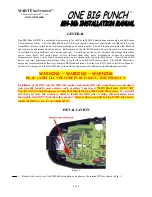
13-21-615 v01 Page 23
Operation with incorrect motor rotation can damage equipment and cause oil
eruption from the compressor inlet. When checking motor rotation, induce
minimum rotation (less than one revolution if possible). Never allow motor to
reach full speed.
Check the compressor unit’s direction of rotation every time the compressor is
reconnected to the power supply.
Operation at excessive discharge air pressure can cause personal injury or
damage to equipment. Do not adjust the full discharge air pressure above the
maximum stamped on the unit nameplate.
5.
Electrical
- Check the wiring diagrams furnished with the unit to be sure it is properly wired. See
Section 4 for general wiring diagrams and Section 2 for installation instructions.
6.
Grounding
- Equipment must be properly grounded according to Section 250 of the National Electrical
Code.
7.
Rotation
- Check for correct motor rotation by jogging the
motor. See “Machine Configuration Menu”
in the Controller Operating and Service Manual. Compressor drive shaft rotation must be clockwise,
standing facing the compressor sheave on gear drive and counter-clockwise on direct drive (50 HP,
150 PSI ONLY).
8.
Plant Delivery Pressure
–
The discharge pressure of the unit is set at the factory. To change the
discharge pressure, set the controls to the desired load pressure.
DO NOT EXCEED THE MAXIMUM
OPERATING PRESSURE ON THE COMPRESSOR NAMEPLATE
. See “Operational Settings” in
the Controller Operating and Service Manual.
9.
Operating Mode
- Refer to Section 4 for detailed information on the control system.
10.
Enclosure
- Check for damaged panels or doors. Check all screws and latches for tightness. Be sure
doors are closed and latched.
Failure to properly ground the compressor package could result in controller
malfunction.
















































